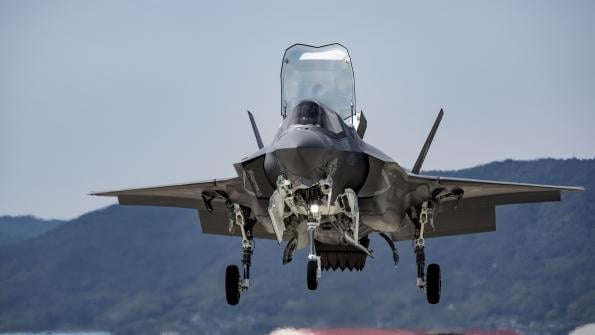
A German think tank is calling on Germany’s defense ministry to reconsider Lockheed Martin’s F-35 as a successor for the country’s Panavia Tornado fleet.
It has been one year since the F-35 was eliminated from the shortlist of combat aircraft being considered for the Tornado replacement, which left only the Boeing F/A-18 Super Hornet and the Eurofighter Typhoon as options. But neither aircraft is qualified to carry the B61 nuclear weapon that equips the Tornado under a dual-key arrangement with the U.S.
Now the influential German Society for Foreign Policy, DGAP, argues that to meet the nuclear mission requirements, Berlin should “revise” its original decision to consider only the F/A-18 and the Eurofighter, with authors Heinrich Brauss and Christian Molling calling for the F-35 to be “included in the comparative analysis and evaluation,” in a new report published Feb. 3.
The authors argue that in light of the deteriorating security situation in Europe, given Russia’s invasion of Ukraine and the deployment of new Russian cruise missiles that ultimately ended the Intermediate-Range Nuclear Forces Treaty, Germany needs to make “an appropriate and reliable contribution” to NATO’s conventional and nuclear components by providing a “suitable successor for the Tornado in good time.”
The authors do not suggest the F-35 would be the best choice for a Tornado replacement, although they note that the platform will become “the fighter aircraft for all relevant planning and procedures in NATO in the next few years.”
But they note that certifying the Eurofighter to carry the B61 “would take a long time,” so it might not be available as a replacement for the Tornado on time. They also say that the Super Hornet could be ready to carry the B61 by 2025, but it would have to be accompanied by other aircraft such as the EA-18G Growler, increasing the cost of operation.
The report also casts doubt on whether the Future Combat Air System (FCAS) that Germany is developing with France and Spain will be available for the nuclear strike mission with the B61.
The authors also argue that adopting the Eurofighter as a replacement for the Tornado could hinder flexibility, as the German air force would end up being reliant on one type for all missions.
The elimination of the F-35 from the shortlist was partly a result of hard lobbying by Paris, which threatened to end cooperation on the FCAS program if the U.S. fighter was selected. The F-35 is believed to be the aircraft of choice for senior officers in the German Air Force, although few will go on the record saying so.
Germany was to start replacing its Tornados starting in 2025, but the schedule for the selection and the award of a contract is far from certain.
Last year, Airbus officials said they were expecting Berlin to issue an updated request for information on the Tornado replacement.






Comments
But countries would also have the option to retain recent single-engine fighters for the low component, or recent twin-engine fighters for the high component, at least for a number of years.
The way to do this could be to have German aircraft carry French ASMP-A nuclear missiles with a dual key system of control. Alternatively French ASMP-A equipped aircraft could be either based in Germany or would be allowed to operate from Germany bases on short notice.
In any case the probability of a 500 km range standoff Mach 3 ASMP-A delivering a weapon on a target would seem to be far higher than an F-35 flying over the target and dropping a nuclear bomb.